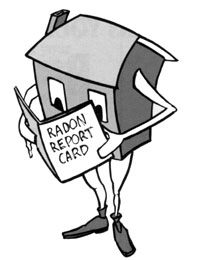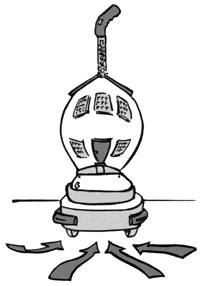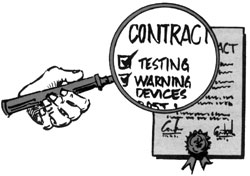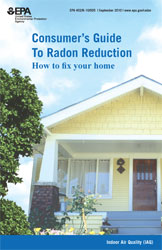
Office of Air and Radiation |
Contents
PDF Version (PDF, 20 pp, 602KB, About PDF) |
Reduce Radon Levels In Your Home
Radon is the second leading cause of lung cancer. The Surgeon General and the EPA recommend testing for radon and reducing radon in homes that have high levels. Fix your home if your radon level is confirmed to be 4 picocuries per liter (pCi/L) or higher. Radon levels less than 4 pCi/L still pose a risk, and in many cases may be reduced. If you smoke and your home has high radon levels, your risk of lung cancer is especially high.
Select A State Certified and/or Qualified Radon Mitigation Contractor
Choose a qualified radon mitigation contractor to fix your home. Start by checking with your state radon office. Many states require radon professionals to be licensed, certified, or registered. You can also contact private radon proficiency programs for lists of privately certified radon professionals in your area.
Radon Reduction Techniques Work
Radon reduction systems work. Some radon reduction systems can reduce radon levels in your home by up to 99%. The cost of fixing a home generally ranges from $800 to $2,500 (with an average cost of $1,200). Your costs may vary depending on the size and design of your home and which radon reduction methods are needed. Hundreds of thousands of people have reduced radon levels in their homes.
Maintain Your Radon Reduction System
Maintaining your radon reduction system takes little effort and keeps the system working properly and radon levels low.
Top of page
You have tested your home for radon, but now what? This guidance is for people who have tested their home for radon and confirmed that they have elevated radon levels -- 4 picocuries per liter (pCi/L) or higher. This guidance can help you:
- Select a qualified radon mitigation contractor to reduce the radon levels in your home
- Determine an appropriate radon reduction method
- Maintain your radon reduction system
If you want information on how to test your home for radon, call your state radon office, read A Citizen's Guide to Radon or, if testing during a home sale, read the Home Buyer's and Seller's Guide to Radon.
Radon is a naturally occurring radioactive gas produced by the breakdown of uranium in soil, rock, and water. Air pressure inside your home is usually lower than pressure in the soil around your home's foundation. Because of this difference in pressure, your house acts like a vacuum, drawing radon in through foundation cracks and other openings. Radon may also be present in well water and can be released into the air in your home when water is used for showering and other household uses. In most cases, radon entering the home through water is a small risk compared with radon entering your home from the soil. In a small number of homes, the building materials (e.g., granite and certain concrete products) can give off radon, although building materials rarely cause radon problems by themselves. In the United States, radon gas in soils is the principal source of elevated radon levels in homes.
Radon is a Cancer-causing, Radioactive Gas
Radon is estimated to cause many thousands of lung cancer deaths each year. In fact, the Surgeon General has warned that radon is the second leading cause of lung cancer in the United States. Only smoking causes more lung cancer deaths. If you smoke and your home has high radon levels, your risk of lung cancer is especially high.
Top of page
What Do Your Radon Test Results Mean?
Selecting a Radon Test Kit
Since you cannon see or smell radon, special equipment is needed to detect it. When you're ready to test your home, contact your state radon office (or visit our radon testing page for information on locating qualified test kits or qualified radon testers. You can also order test kits and obtain information from a radon hotline. There are two types of radon testing devices. Passive radon testing devices do not need power to function. These include charcoal canisters, alpha-track detectors, charcoal liquid scintillation devices, and electret ion chamber detectors. Both short- and long-term passive devices are generally inexpensive. Active radon testing devices require power to function and usually provide hourly readings and an average result for the test period. These include continuous radon monitors and continuous working level monitors, and these test may cost more. A state or local official can explain the differences between devices and recommend ones which are more appropriate for your needs and expected testing conditions. Make sure to use a radon testing devices from a qualified laboratory.
Any radon exposure has some risk of causing lung cancer. The lower the radon level in your home, the lower your family's risk of lung cancer. The amount of radon in the air is measured in "picocuries of radon per liter of air," or "pCi/L." Sometimes test results are expressed in Working Levels, "WL," rather than picocuries per liter of air. A level of 0.016 WL is usually equal to about 4 pCi/L in a typical home.
The U.S. Congress has set a long-term goal that indoor radon levels be no more than outdoor levels; about 0.4 pCi/L of radon is normally found in the outside air. EPA recommends fixing your home if the results one long-term test or the average of two short-term tests show radon levels of 4 pCi/L (or 0.016 WL) or higher. With today's technology, radon levels in most homes can be reduced to 2 pCi/L or below. You may also want to consider fixing if the level is between 2 and 4 pCi/L.
A short-term test remains in your home for 2 days to 90 days, whereas a long-term test remains in your home for more than 90 days. All radon tests should be taken for a minimum of 48 hours. A short-term test will yield faster results, but a long-term test will give a better understanding of your home's year-round average radon level.
The EPA recommends two categories of radon testing. One category is for concerned homeowners or occupants whose house is not for sale; refer to EPA's A Citizen's Guide to Radon for testing guidance. The second category is for real estate transactions; refer to EPA's Home Buyer's and Seller's Guide to Radon, which provides guidance and answers to some common questions.
EPA recommends that you have a qualified radon mitigation contractor fix your home because lowering high radon levels requires specific technical knowledge and special skills. Without the proper equipment or technical knowledge, you could actually increase your radon level or create other potential hazards and additional costs. However, if you decide to do the work yourself, get information on appropriate training courses and copies of EPA's technical guidance documents.
EPA recommends that you use a state certified and/or qualified radon mitigation contractor trained to fix radon problems. You can determine a service provider's qualifications to perform radon measurements or to mitigate your home in several ways. First, check with your state radon office. Many states require radon professionals to be licensed, certified, or registered, and to install radon mitigation systems that meet state requirements. Most states can provide you with a list of knowledgeable radon service providers doing business in the state. In states that don't regulate radon services, ask the contractor if they hold a professional proficiency or certification credential, and if they follow industry consensus standards such as the American Society for Testing and Materials (ASTM) Standard Practice for Installing Radon Mitigation Systems in Existing Low-Rise Residential Buildings, E2121 (February 2003). You can contact private proficiency programs for lists of privately-certified professionals in your area. Such programs usually provide members with a photo-ID, which indicates their qualification(s) and the ID-card's expiration date.
Top of page

Choose a contractor to fix a radon problem just as you would choose someone to do other home repairs. It is wise to get more than one estimate, to ask for references, and to contact some of those references to ask if they are satisfied with the contractors' work. Also, ask your state radon office or your county/state consumer protection office for information about the contractors.
Use this check-list when evaluating and comparing contractors and ask the following questions:
| YES | NO | ||
 |
 |
Will the contractor provide references or photographs, as well as test results of 'before' and 'after' radon levels of past radon reduction work? |
|
 |
 |
Can the contractor explain what the work will involve, how long it will take to complete, and exactly how the radon reduction system will work? |
|
 |
 |
Does the contractor charge a fee for any diagnostic tests? Although many contractors give free estimates, they may charge for diagnostic tests. These tests help determine what type of radon reduction system should be used and in some cases are necessary, especially if the contractor is unfamiliar with the type of house structure or the anticipated degree of difficulty. See "Radon Reduction Techniques" for more on diagnostic tests. | |
 |
 |
Did the contractor inspect your home's structure before giving you an estimate? |
|
 |
 |
Did the contractor review the quality of your radon measurement results and determine if appropriate testing procedures were followed? |
Compare the contractors' proposed costs and consider what you will get for your money, taking into account: (1) a less expensive system may cost more to operate and maintain; (2) a less expensive system may have less aesthetic appeal; (3) a more expensive system may be best for your house; and, (4) the quality of the building material will affect how long the system lasts.
Does the contractor's proposal and estimate include:
| YES | NO | ||
 |
 |
Proof of state certification and/or professional proficiency or certification credentials? |
|
 |
 |
Proof of liability insurance and being bonded, and having all necessary licenses to satisfy local requirements? |
|
 |
 |
Diagnostic testing prior to design and installation of a radon reduction system? |
|
 |
 |
Installation of a warning device to caution you if the radon reduction system is not working correctly? |
|
 |
 |
Testing after installation to make sure the radon reduction system works well? |
|
 |
 |
A guarantee to reduce radon levels to 4 pCi/L or below, and if so, for how long? |
Ask the contractor to prepare a contract before any work starts. Carefully read the contract before you sign it. Make sure everything in the contract matches the original proposal. The contract should describe exactly what work will be done prior to and during the installation of the system, what the system consists of, and how the system will operate. Many contractors provide a guarantee that they will adjust or modify the system to reach a negotiated radon level. Carefully read the conditions of the contract describing the guarantee. Carefully consider optional additions to your contract which may add to the initial cost of the system, but may be worth the extra expense. Typical options might include an extended warranty, a service plan, and/or improved aesthetics.
Important information that should appear in the contract includes:
| The total cost of the job, including all taxes and permit fees; how much, if any, is required for a deposit; and when payment is due in full. |
|
| The time needed to complete the work. |
|
| An agreement by the contractor to obtain necessary permits and follow required building codes. |
|
| A statement that the contractor carries liability insurance and is bonded and insured to protect you in case of injury to persons, or damage to property, while the work is done. |
|
| A guarantee that the contractor will be responsible for damage and clean-up after the job. |
|
| Details of any guarantee to reduce radon below a negotiated level. |
|
| Details of warranties or other optional features associated with the hardware components of the mitigation system. |
|
| A declaration stating whether any warranties or guarantees are transferable if you sell your home. |
|
| A description of what the contractor expects the homeowner to do (e.g., make the work area accessible) before work begins. |
Top of page
What to Look for in a Radon Reduction System
In selecting a radon reduction method for your home, you and your contractor should consider several things, including: how high your initial radon level is, the costs of installation and system operation, your house size and your foundation type.
 Installation and Operating Costs
Installation and Operating Costs
The cost of a contractor fixing a home generally ranges from $800 to $2,500, depending on the characteristics of the house and choice of radon reduction methods. The average cost of a radon reduction system is about $1,200.
Most types of radon reduction systems cause some loss of heated or air conditioned air, which could increase your utility bills. How much your utility bills will increase will depend on the climate you live in, what kind of reduction system you select, and how your house is built. Systems that use fans are more effective in reducing radon levels; however, they will slightly increase your electric bill. The "Installation and Operating Cost Table" lists the installation and average operating costs for different radon reduction systems and describes the best use of each method.
Top of page
There are several methods that a contractor can use to lower radon levels in your home. Some techniques prevent radon from entering your home while others reduce radon levels after it has entered. EPA generally recommends methods which prevent the entry of radon. Soil suction, for example, prevents radon from entering your home by drawing the radon from below the house and venting it through a pipe, or pipes, to the air above the house where it is quickly diluted.
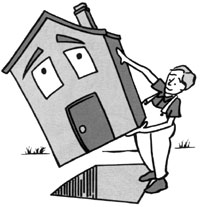 Any information that you may have about the construction of your house could help your contractor choose the best system. Your contractor will perform a visual inspection of your house and design a system that considers specific features of your house. If this inspection fails to provide enough information, the contractor will need to perform diagnostic tests during the initial phase of the installation to help develop the best radon reduction system for your home. For instance, your contractor can use chemical smoke to find the source and direction of air movement. A contractor can learn air flow sources and directions by watching a small amount of smoke that he or she shot into holes, drains, sumps, or along cracks. The sources of air flow show possible radon routes. A contractor may have concerns about backdrafting of combustion appliances when considering radon mitigation options, and may recommend that the homeowner have the appliance(s) checked by a qualified inspector.
Any information that you may have about the construction of your house could help your contractor choose the best system. Your contractor will perform a visual inspection of your house and design a system that considers specific features of your house. If this inspection fails to provide enough information, the contractor will need to perform diagnostic tests during the initial phase of the installation to help develop the best radon reduction system for your home. For instance, your contractor can use chemical smoke to find the source and direction of air movement. A contractor can learn air flow sources and directions by watching a small amount of smoke that he or she shot into holes, drains, sumps, or along cracks. The sources of air flow show possible radon routes. A contractor may have concerns about backdrafting of combustion appliances when considering radon mitigation options, and may recommend that the homeowner have the appliance(s) checked by a qualified inspector.
Another type of diagnostic test is a "soil communication test." This test uses a vacuum cleaner and chemical smoke to determine how easily air can move from one point to another under the foundation. By inserting a vacuum cleaner hose in one small hole and using chemical smoke in a second small hole, a contractor can see if the smoke is pulled down into the second hole by the force of the vacuum cleaner's suction. Watching the smoke during a soil communication test helps a contractor decide if certain radon reduction systems would work well in your house.
Whether diagnostic tests are needed is decided by details specific to your house, such as the foundation design, what kind of material is under your house, and by the contractor's experience with similar houses and similar radon test results.
Your house type will affect the kind of radon reduction system that will work best. Houses are generally categorized according to their foundation design. For example: basement, slab-on-grade (concrete poured at ground level), or crawlspace (a shallow unfinished space under the first floor). Some houses have more than one foundation design feature. For instance, it is common to have a basement under part of the house and to have a slab-on-grade or crawlspace under the rest of the house. In these situations a combination of radon reduction techniques may be needed to reduce radon levels to below 4 pCi/L.
Radon reduction systems can be grouped by house foundation design. Find your type of foundation design above and read about which radon reduction systems may be best for your house.
Basement and Slab-on-Grade Houses
In houses that have a basement or a slab-on-grade foundation, radon is usually reduced by one of four types of soil suction: subslab suction, drain tile suction, sump hole suction, or block wall suction.
Active Subslab suction (also called subslab depressurization) is the most common and usually the most reliable radon reduction method. One or more suction pipes are inserted through the floor slab into the crushed rock or soil underneath. They also may be inserted below the concrete slab from outside the house. The number and location of suction pipes that are needed depends on how easily air can move in the crushed rock or soil under the slab, and on the strength of the radon source. Often, only a single suction point is needed.
A contractor usually gets this information from visual inspection, from diagnostic tests, and/or from experience. A radon vent fan connected to the suction pipe(s) draws the radon gas from below the house and releases it into the outdoor air while simultaneously creating a negative pressure (vacuum) beneath the slab. Common fan locations include unconditioned house and garage spaces, including attics, and the exterior of the house.
Passive subslab suction is the same as active subslab suction except it relies on natural pressure differentials and air currents instead of a fan to draw radon up from below the house. Passive subslab suction is usually associated with radon-resistant features installed in newly constructed homes. Passive subslab is generally not as effective in reducing high radon levels as active subslab suction.
Some houses have drain tiles or perforated pipe to direct water away from the foundation of the house. Suction on these tiles or pipes is often effective in reducing radon levels.
One variation of subslab and drain tile suction is sump hole suction. Often, when a house with a basement has a sump pump to remove unwanted water, the sump can be capped so that it can continue to drain water and serve as the location for a radon suction pipe.
Block wall suction can be used in basement houses with hollow block foundation walls. This method removes radon and depressurizes the block wall, similar to subslab suction. This method is often used in combination with subslab suction.
Crawlspace Houses
An effective method to reduce radon levels in crawlspace houses involves covering the earth floor with a high-density plastic sheet. A vent pipe and fan are used to draw the radon from under the sheet and vent it to the outdoors. This form of soil suction is called submembrane suction, and when properly applied is the most effective way to reduce radon levels in crawlspace houses. Another less-favorable option is active crawlspace depressurization which involves drawing air directly from the crawlspace using a fan. This technique generally does not work as well as submembrane suction and requires special attention to combustion appliance backdrafting and sealing the crawlspace from other portions of the house, and may also result in increased energy costs due to loss of conditioned air from the house.
In some cases, radon levels can be lowered by ventilating the crawlspace passively (without the use of a fan) or actively (with the use of a fan). Crawlspace ventilation may lower indoor radon levels both by reducing the home's suction on the soil and by diluting the radon beneath the house. Passive ventilation in a crawlspace is achieved by opening vents, or installing additional vents. Active ventilation uses a fan to blow air through the crawlspace instead of relying on natural air circulation. In colder climates, for either passive or active crawlspace ventilation, water pipes, sewer lines and appliances in the crawlspace may need to be insulated against the cold. These ventilation options could result in increased energy costs for the house.
Other Types of Radon Reduction Methods
Other radon reduction techniques that can be used in any type of house include: sealing, house/room pressurization, heat recovery ventilation, and natural ventilation.
Sealing cracks and other openings in the foundation is a basic part of most approaches to radon reduction. Sealing the cracks limits the flow of radon into your home thereby making other radon reduction techniques more effective and cost-efficient. It also reduces the loss of conditioned air. EPA does not recommend the use of sealing alone to reduce radon because, by itself, sealing has not been shown to lower radon levels significantly or consistently. It is difficult to identify and permanently seal the places where radon is entering. Normal settling of your house opens new entry routes and reopens old ones.
House/room pressurization uses a fan to blow air into the basement or living area from either upstairs or outdoors. It attempts to create enough pressure at the lowest level indoors (in a basement for example) to prevent radon from entering into the house. The effectiveness of this technique is limited by house construction, climate, other appliances in the house, and occupant lifestyle. In order to maintain enough pressure to keep radon out, the doors and windows at the lowest level must not be left opened, except for normal entry and exit. This approach generally results in more outdoor air being introduced into the home, which can cause moisture intrusion and energy penalties. Consequently, this technique should only be considered after the other, more-common techniques have not sufficiently reduced radon.
A heat recovery ventilator (HRV), also called an air-to-air heat exchanger, can be installed to increase ventilation which will help reduce the radon levels in your home. An HRV will increase ventilation by introducing outdoor air while using the heated or cooled air being exhausted to warm or cool the incoming air. HRVs can be designed to ventilate all or part of your home, although they are more effective in reducing radon levels when used to ventilate only the basement. If properly balanced and maintained, they ensure a constant degree of ventilation throughout the year. HRVs also can improve air quality in houses that have other indoor pollutants. There could be significant increase in the heating and cooling costs with an HRV, but not as great as ventilation without heat recovery (see the "Installation and Operating Cost Table").
Some natural ventilation occurs in all houses. By opening windows, doors, and vents on the lower floors you increase the ventilation in your house. This increase in ventilation mixes outdoor air with the indoor air containing radon, and can result in reduced radon levels. However, once windows, doors and vents are closed, radon concentrations most often return to previous values within about 12 hours. Natural ventilation in any type of house should normally be regarded as only a temporary radon reduction approach because of the following disadvantages: loss of conditioned air and related discomfort, greatly increased costs of conditioning additional outside air, and security concerns.
Checking Your Contractor's Work
Below is a list of basic installation requirements that your contractor should meet when installing a radon reduction system in your home. It is important to verify with your contractor that the radon mitigation standards are properly met to ensure that your radon reduction system will be effective. You can also check with your state radon office to see if there are state requirements that your contractor must meet.
| Radon reduction systems must be clearly labeled. This will avoid accidental changes to the system which could disrupt its function. |
|
| The exhaust pipe(s) of soil suction systems must vent above the surface of the roof and 10 feet or more above the ground, and at least 10 feet away from windows, doors, or other openings that could allow the radon to reenter the house, if the exhaust pipe(s) do not vent at least 2 feet above these openings. |
|
| The exhaust fan must not be located in or below a livable area. For instance, it should be in an unoccupied attic of the house or outside - not in a basement! |
|
| If installing an exhaust fan outside, the contractor must install a fan that meets local building codes for exterior use. |
|
| Electrical connections of all active radon reduction systems must be installed according to local electrical codes. |
|
| A warning device must be installed to alert you if an active system stops working properly. Examples of system failure warning devices are: a liquid gauge, a sound alarm, a light indicator, and a dial (needle display) gauge. The warning device must be placed where it can be seen or heard easily. Your contractor should check that the warning device works. Later on, if your monitor shows that the system is not working properly, call a contractor to have it checked. |
|
| A post-mitigation radon test should be done within 30 days of system installation, but no sooner than 24 hours after your system is in operation with the fan on, if it has one. The contractor may perform a post-mitigation test to check his work and the initial effectiveness of the system; however, it is recommended that you also get an independent follow-up radon measurement. Having an independent tester perform the test, or conducting the measurement yourself, will eliminate any potential conflict of interest. To test the system's effectiveness, a 2-7 day measurement is recommended. Test conditions: windows and doors must be closed 12 hours before and during the test, except for normal entry/exit. |
|
| Make sure your contractor completely explains your radon reduction system, demonstrates how it operates, and explains how to maintain it. Ask for written operating and maintenance instructions and copies of any warranties. |
Living in a House with a Radon Reduction System
Remember, the fan should NEVER be turned off; it must run continuously for the system to work correctly.
Maintaining Your Radon Reduction System
Similar to a furnace or chimney, radon reduction systems need some occasional maintenance. You should look at your warning device on a regular basis to make sure the system is working correctly. Fans may last for five years or more (manufacturer warranties tend not to exceed five years) and may then need to be repaired or replaced. Replacing a fan will cost around $200 - $350 including parts and labor. It is a good idea to retest your home at least every two years to be sure radon levels remain low.
The filter in an HRV requires periodic cleaning and should be changed twice a year. Replacement filters for an HRV are easily changed and are priced between $10 and $25. Ask your contractor where filters can be purchased. Also, the vent that brings fresh air in from the outside needs to be inspected for leaves and debris. The ventilator should be checked annually by a heating, ventilating, and air-conditioning professional to make sure the air flow remains properly balanced. HRVs used for radon control should run all the time.
Remodeling Your Home After Radon Levels Have Been Lowered
If you decide to make major structural changes to your home after you have had a radon reduction system installed (such as converting an unfinished basement area into living space), ask your radon contractor whether these changes could void any warranties. If you are planning to add a new foundation for an addition to your house, ask your radon contractor about what measures should be taken to ensure reduced radon levels throughout the home. After you remodel, retest in the lowest lived-in area to make sure the construction did not reduce the effectiveness of the radon reduction system.
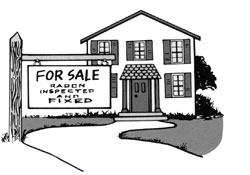
If you are buying or selling a home and need to make decisions about radon, consult EPA's Home Buyer's and Seller's Guide to Radon. If you are selling a home that has a radon reduction system, inform potential buyers and supply them with information about your system's operation and maintenance. If you are building a new house, consider that it is almost always less expensive to build radon-resistant features into new construction than it is to fix an existing house that has high radon levels. Ask your builder if he or she uses radon-resistant construction features. Your builder can refer to EPA's document Building Radon Out: A Step-by-Step Guide On How to Build Radon-Resistant Homes, or your builder can work with a qualified contractor to design and install the proper radon reduction system. To find a qualified contractor contact your state radon office or contact one or both of the national radon proficiency programs, see for contact information. All homes should be tested for radon and elevated radon levels should be reduced. Even new homes built with radon-resistant features should be tested after occupancy to ensure that radon levels are below 4 pCi/L. If you have a test result of 4 pCi/L or more, you can have a qualified mitigator easily add a vent to an existing passive system for about $300 and further reduce the radon level in your home.
Top of page
Most often, the radon in your home's indoor air can come from two sources, the soil or your water supply. Compared to radon entering your home through water, radon entering your home through soil is usually a much larger risk. If you are concerned about radon and you have a private well, consider testing for radon in both air and water. By testing for radon in both air and water, the results could enable you to more completely assess the radon mitigation option(s) best suited to your situation. The devices and procedures for testing your home's water supply are different from those used for measuring radon in air.
The radon in your water supply poses an inhalation risk and a small ingestion risk. Most of your risk from radon in water comes from radon released into the air when water is used for showering and other household purposes. Research has shown that your risk of lung cancer from breathing radon in air is much larger than your risk of stomach cancer from swallowing water with radon on it.
Radon in your home's water is not usually a problem when its source is surface water. A radon in water problem is more likely when its source is ground water, e.g., a private well or a public water supply system that uses ground water. Some public water systems treat their water to reduce radon levels before it is delivered to your home. If you are concerned that radon may be entering your home through the water and your water comes from a public water supply, contact your water supplier.
If you've tested your private well and have a radon in water problem, it can be easily fixed. Your home's water supply can be treated in one of two ways. Point-of-entry treatment for the whole house can effectively remove radon from the water before it enters your home's water distribution system. Point-of-entry treatment usually employs either granular activated carbon (GAC) filters or aeration systems. While GAC filters usually cost less than aeration systems, filters can collect radioactivity and may require a special method of disposal. Both GAC filters and aeration systems have advantages and disadvantages that should be discussed with your state radon office or a water treatment professional. Point-of-use treatment devices remove radon from your water at the tap, but only treat a small portion of the water you use, e.g., the water you drink. Point-of-use devices are not effective in reducing the risk from breathing radon released into the air from all water used in the home.
For information on radon in water, testing and treatment, and radon in drinking water standards, or for general help, call your state radon office > Your state radon office can assist you in obtaining radon-in-water test kits and interpreting test results.
Top of page
Installation and Operating Cost Table
| Technique | Typical Radon Reduction | Typical Range of Installation Costs (Contractor) |
Typical Operating Cost Range for Fan Electricity & Heated/ Cooled Air Loss (Annual) |
Comments |
|---|---|---|---|---|
| Subslab Suction (Subslab Depressurization) |
50 - 99% | $800 - $2,500 | $50 - $200 | Works best if air can move easily in material under slab. |
| Passive Subslab Suction | 30 - 70% | $550 - $2,250 | There may be some energy penalties | May be more effective in cold climates; not as effective as active subslab suction. |
| Draintile Suction | 50 - 99% | $800 - $1,700 | $50 - $200 | Can work with either partial or complete drain tile loops. |
| Blockwall Suction | 50 - 99% | $1,500 - $3,000 | $100 - $400 | Only in houses with hollow blockwalls; requires sealing of major openings. |
| Sump Hole Suction | 50 - 99% | $800 - $2,500 | $50 - $250 | Works best if air moves easily to the sump under the slab. |
| Submembrane Depressurization in a Crawlspace | 50 - 99% | $1,000 - $2,500 | $50 - $250 | Less heat loss than natural ventilation in cold winter climates. |
| Natural Ventilation in a Crawlspace | 0 - 50% | none $200 - $500 if additional vents installed |
There may be some energy penalties. | Costs variable |
| Sealing of Radon Entry Routes | See Comments | $100 - $2,000 | None | Normally only used with other techniques; proper materials & installation required |
| House (Basement) Pressurization | 50 - 99% | $500 - $1,500 | $150 - $500 | Works best with tight basement isolated from outdoors & upper floors. |
| Natural Ventilation | Variable/ Temporary |
None $200 - $500 if additional vents installed |
$100 - $700 | Significant heated/cooled air loss; operating costs depend on utility rates & amount of ventilation. |
| Heat Recovery Ventilation (HRV) | Variable/ See Comments |
$1,200 - $2,500 | $75 - $500 for continuous operation | Limited use; effectiveness limited by radon concentration and the amount of ventilation air available for dilution by the HRV. Best applied to limited-space areas like basements. |
| Private Well Water Systems: Aeration | 95 - 99% | $3,000 - $4,500 | $50 - $150 | Generally more efficient than GAC; requires annual cleaning to maintain effectiveness and to prevent contamination; requires venting radon to outdoors. |
| Private Well Water Systems: Granular Activated Carbon (GAC) | 85 - 99% | $1,000 - $3,000 | None | Less efficient for higher levels than aeration; use for moderate levels (around 5,000 pCi/L or less in water); radioactive radon by-products can build on carbon; may need radiation shield around tank & care in disposal. |
NOTES:
|
||||
Top of page
- State Radon Contacts - Up-to-date phone information about how to contact your state radon office is available at just click on your state.
- Radon Website - EPA's radon website - - includes links to publications, hotlines, private proficiency programs and more.
- Regional and State Offices - Check out for a listing of your local contact information just click on your state.
- Publications - Most EPA radon publications are available free, see below for information on how to order.
- Hotlines
- - Operated by the National Safety Council
 in partnership with EPA. Order radon test kits by phone or on-line).
in partnership with EPA. Order radon test kits by phone or on-line).
- - Operated by the National Safety Council
 in partnership with EPA. Get a live operator who can help you with your radon questions.
in partnership with EPA. Get a live operator who can help you with your radon questions.
- - Safe Drinking Water Hotline (epa.gov/safewater/radon.html), privately operated under contract to EPA. For general information on drinking water, radon in water, testing and treatment, and radon drinking water questions.
- - Operated by the National Safety Council
Top of page
You can order Indoor Air Quality publications from EPA's National Service Center for Environmental Publications (NSCEP):
U.S. Environmental Protection Agency
National Service Center for Environmental Publications (NSCEP)
NSCEP operates a Toll-free phone service for EPA Publication Assistance with live customer service representative assistance Monday through Friday from 9:00am-5:30pm eastern time. Voice Mail is available after operating hours. You can fax or e-mail your publication requests. For technical assistance with NSCEP web pages, write to:
Please use the EPA Document Number, which is usually bolded or highlighted, when ordering from NSCEP.
How Do I Order Other EPA Publications?
| U.S. Surgeon General Health Advisory
"Indoor radon is the second-leading cause of lung cancer in the United States and breathing it over prolonged periods can present a significant health risk to families all over the country. It's important to know that this threat is completely preventable. Radon can be detected with a simple test and fixed through well-established venting techniques. January 2005 |
Top of page

